Caleb J. Ross's Blog, page 63
May 3, 2012
The Author Who Gets Free Drinks: a (Hopefully) True Story, live (again) at Broken Piano for President
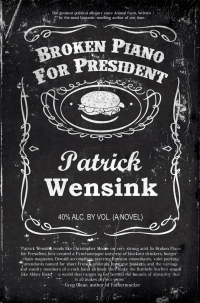 Patrick Wensink kindly re-posted my short essay thing “The Author Who Gets Free Drinks: A (Hopefully) True Story,” over at his blog, Broken Piano for President, which not coincidentally is the title of his recently released book. Head over to the site, take in the story. It’s about Tom Waits, free drinks, and Southwest Airlines. Here’s a lick:
Patrick Wensink kindly re-posted my short essay thing “The Author Who Gets Free Drinks: A (Hopefully) True Story,” over at his blog, Broken Piano for President, which not coincidentally is the title of his recently released book. Head over to the site, take in the story. It’s about Tom Waits, free drinks, and Southwest Airlines. Here’s a lick:
This is the already true part: in June of 2008 I stood on a beach in San Diego wearing a full suit, paying more attention to my watch than to the ocean in front of me. For a boy from Kansas City, where the largest body of water might be a wort vessel at the Boulevard Brewery, this transposed priority says a lot. I had a flight, and as always, the airline schedule superseded any perceived relaxation. And it’s especially hard to relax when, with my suit beachwear I looked the part of a misplaced predator. Bikinied women covered themselves as I strolled the boardwalk.
May 2, 2012
Because if I can’t have Tom Waits read my story…
…Phil Jourdan is a damn good runner-up.
Here he reads a page or so from my story “Click-Clack” which a lot of people seem to really like (both the story and Phil’s voice).
Novel Easter Eggs, part 3 – Catch-22 and Gatsby eggs (Video Blog Ep 009)
Easter Eggs, you know, those hidden references in movies, books, websites, and more that aren’t necessary but are damn fun in a treasure hunt sort of way. I planted a few (13 to be exact) in my newest novel, I Didn’t Mean to be Kevin. In this, part 3 (of4), I reveal references to Joseph Heller (Catch-22) and F. Scott Fitzgerald (The Great Gatsby).
Eleven down, two to go
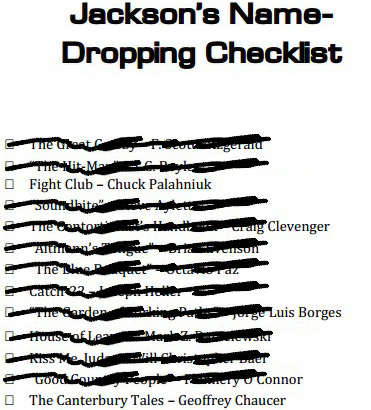
After watching, be sure to subscribe to my YouTube channel to stay updated on new videos
May 1, 2012
Novel Easter Eggs, part 2 – Human Parts Museum eggs (Video Blog Ep 008)
Easter Eggs, you know, those hidden references in movies, books, websites, and more that aren’t necessary but are damn fun in a treasure hunt sort of way. I planted a few (13 to be exact) in my newest novel, I Didn’t Mean to be Kevin. In this, part 2, I reveal references to T.C. Boyle, Steve Aylett, Craig Clevenger, Brian Evenson, Will Christopher Baer, Octavio Paz, and Flannery O’Connor.
Seven down, four to go.

After watching, be sure to subscribe to my YouTube channel to stay updated on new videos
April 28, 2012
Novel Easter Eggs, part 1 – Metafiction eggs (Video Blog Ep 007)
Easter Eggs, you know, those hidden references in movies, books, websites, and more that aren’t necessary but are damn fun in a treasure hunt sort of way. I planted a few (13 to be exact) in my newest novel, I Didn’t Mean to be Kevin, not on the assumption that some reader would be thrilled by a find in one of my books, but because the concept actually worked well with the theme of the novel. The theme being that people need validation. Jackson, the narrator, validates himself as a person by telling crazy stories to strangers. I, as an author, validate myself by telling you about all the cool books I’ve read.
Two down, eleven to go.
[image error]
After watching, be sure to subscribe to my YouTube channel to stay updated on new videos
April 26, 2012
Writer’s Block is Just an Excuse for Broken Storytelling

Just live, late, late last night, a new post over at Phil Jourdan’s Slothrop blog.
Writer’s block has nothing to do with motivation (if the story is working, you’ll have plenty of motivation). It has nothing to do with a weak plot (plenty of great books are weak on plot; The Great Gatsby is “guy moves into a house next to rich guy”…that’s about it). It has nothing to do with your own seemingly problematic writing environment (Chuck Palahniuk wrote Choke while bound up in a hospital bed; you aren’t allowed to complain). Most of the time writer’s block is simply your brain’s reaction to a weakness in your story.
Head over to Slothrop to read the post. Leave a comment. Let Phil know how much you love the article. Maybe he will have me back.
Also, as a bonus, this article can act as a glimpse of what I’ll be teaching for June’s Tallgrass Writing Workshop at Emporia State University. If you like the article and will be in Kansas in June, sign up for the workshop.
April 23, 2012
Three books that break the rules yet still succeed (Video Blog Ep 006)
Rules are important, especially rules that govern how to write effective prose. But, in the hands of masters, those rules can be broken to great effect. I this, this newest episode of The World’s First Author Video Blog, I examine how three well-known books–Brett Easton Ellis’ American Psycho, Mark Z. Danielewski’s House of Leaves, and Jose Saramago’s Blindness–break basic writing rules, but do so successfully.
After watching, be sure to subscribe to my YouTube channel to stay updated on new videos
April 18, 2012
Micro-Syndication Magic: How to Annoy Many People At Once Using Social Network Syndication
The people in my head often ask me, “Caleb, how are you seemingly in so many places online at once?” The simple truth is: magic. But not everyone is born with this gift (or curse, depending on which side of the superhero spectrum I’m internally agonizing over at the time). Over the years I’ve built up a failsafe system, though, so should Cash-4-Kryptonite stores suddenly saturate my suburb, I’ve got measures in place.
Here’s my method.
1. Establish a “content spring”
I’m an organization nut. I need structure to survive. Online, when new social media networks materialize daily, organization can be tough. It is important to establish a “content spring,” a source from which most of your content will originate. The goal being to focus content creation efforts in a single place to avoid feeling overwhelmed by so many points of entry. In a perfect world, with perfect organization, you would be able to syndicate your content throughout your social networks with a single push of the “publish post” button.
The most logical content spring is the good ol’ fashion blog. Blogging platforms have evolved considerably over the past few years, with most blog sites having enormous inbuilt configurability. For The World’s First Author Blog I use the WordPress platform, which is perhaps the most configurable of all blogging software. Expect most of this post to skew appropriately.
2. Map your content routes (or, “build some tributaries,” if you want to maintain the spring motif)
Step three will detail a few of the tools I use to get my content from the spring to..I don’t know, the ocean maybe, but before that, in keeping with my penchant for organizational nerdery, it’s important to map out exactly where you would like your different types of content to ultimately appear. Emphasis intentional: the idea of micro-syndication relies of focusing your content for specific audiences, even niche audiences within your own readership.
“But Caleb, I want ALL of the content to go EVERYWHERE.” Well, hypothetical dissenter, while total media saturation may seem like a good goal, resources, time, and an ethical aversion to spamming friends and strangers should keep you from acting on this impulse.
The goal of micro-syndication is to ensure that the right content gets to the right people. When you write a fantastic blog post about micro-syndication, your family and bar buddies on Facebook might not care. And all those Twitter bots that you think hang onto your every tweet, they don’t care either. But your readers and your marketing and social media friends might care a lot.
I’ll use myself as an example. I have a personal Facebook page, a professional author Facebook page, various Twitter accounts (primarily my @calebjross account), a LinkedIn profile, and a few other profiles and websites. When I write a blog post, I don’t necessarily want to bombard every contact. What to do?
3. Establish the filters (or, setting up strategic dams, or whatever fits with the spring thing. I’m beginning to regret this stupid running metaphor.)
Know which tools are available and how they can help. Here are a few I use daily.

For highly customizable distribution to Facebook, Twitter, and LinkedIn (and fingers crossed more platforms in the future), nothing beats Twitterfeed. By using RSS feeds (which come built-in with most blogging platforms) Twitterfeed allows the user to direct specific feeds to specific social sites. What makes this system great is that by using category and/or tag data from your blogging platform, you can fine-tune the distribution path of your content.
For example, I have my main homepage feed:
www.calebjross.com/feed (“feed” may be a variety of RSS extensions. The WordPress default is “feed”)
Which I send to my author Facebook page as well as my Twitter account (both accounts I use almost exclusively for reader/writer information).
However, sometimes I create content on my homepage blog that isn’t very writerly, content that perhaps is better meant for those friends, family, and bots. In that case, I simply categorize the post as “un-writerly,” which creates this feed:
Twitterfeed has been set up to publish only posts from this feed to my personal Facebook page. Neat.

YouTube Playlists combined with Shortstack and the YouTube SEO Playlist plugin
With videos, my content spring is YouTube (I could host videos on my own site, but why the hell would I do that?) Now, take the concept of categories and tags described above and apply to video playlists. As I upload videos to the Caleb J. Ross YouTube channel, I assign them to playlists organized primarily for the purpose of syndication.
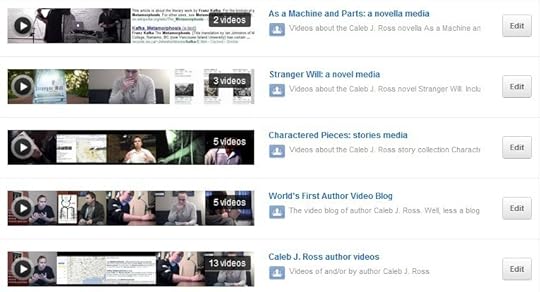
The next step is simply finding tools to aggregate the videos. This is where the Shortstack app and the YouTube SEO Playlist Wordpress plugin come into play. Using the YouTube SEO Playlist plugin I am able to have videos from specific playlists automatically populate on my website. Head over to any of my book pages (Charactered Pieces: stories, for example) or my Author Video Blog page. Notice that only Charactered Pieces: stories related videos appear on the book page and only episodes in my author video blog series appear on the Author Video Blog page? That syndication is entirely automatic.
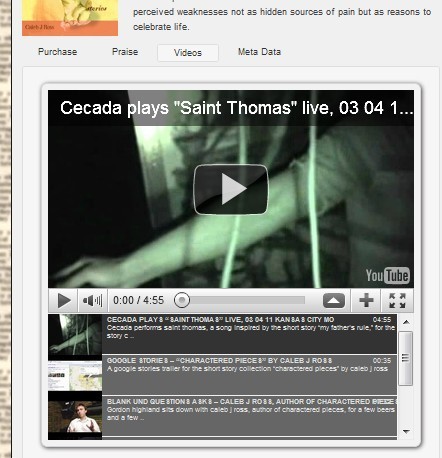
This very same concept has been applied to my author Facebook page, using the Shortstack app. Notice the dropdown menu used for selecting playlists. Awesome.

Another syndication solution to consider is Ping.fm. This service allows a single social network message to populate to 30+ different networks. It sounds pretty great until you realize that most of the networks are small, lesser-known properties (myYearbook, StreetMavens, Yammer, and others). I haven’t used Ping.fm yet (this post will be the first I attempt to distribute using the service). If anyone out there has used the service, I’d love to know your thoughts. And in keeping with the ease of syndication theme here, the WPing.FM plugin is available to further streamline distribution by connecting WordPress with Ping.fm.

Tumblr and the Tumblrize WordPress plugin
Tumblr is an enormously popular blogging platform, thanks in part to its effective merging of twitter-like following capabilities, Facebook-like social group curation, and traditional long form blogging capabilities. Because the network is so huge, it’s important for an author to be there. Luckily, the Tumblrize plugin is here to auto-populate posts from a primary blog to a Tumblr blog. And I know, all you SEOs out there, that I run the risk of duplicate content. For now, I’m testing that risk.
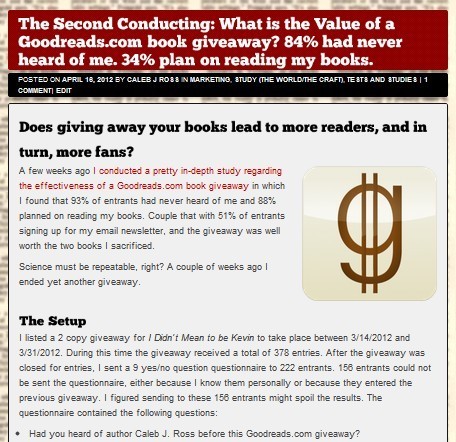
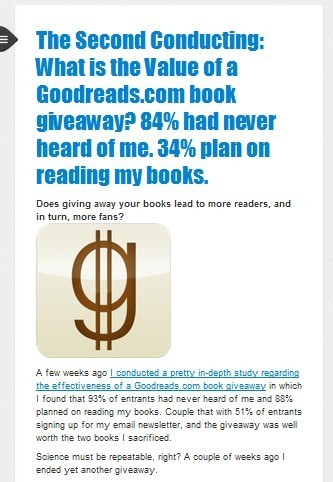
On-Site Syndication/On-Site Curation
Micro-syndication is important, but what about ensuring that the content you create is easily accessible to the right visitors on your site itself? I call this…wait for it…on-site syndication (I provide naming things consulting services at a fair rate). Traditionally, on-site organization has simply been part of a greater conversation called site navigation. But I think it deserves specific attention.
One of the most effective examples of on-site syndication/curation is my use of category pages to organize particularly important blog post categories, effectively creating a type of micro-site with each category. Check out my SEO for Authors category (screenshot below), Book Marketing Tests & Studies category, or the World’s First Author Podcast category for examples.
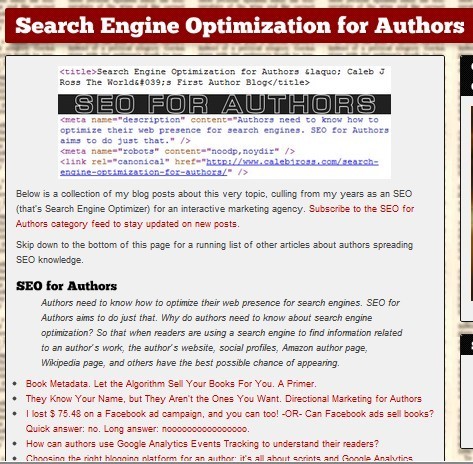
April 16, 2012
The Second Conducting: What is the Value of a Goodreads.com book giveaway? 84% had never heard of me. 34% plan on reading my books.

A few weeks ago I conducted a pretty in-depth study regarding the effectiveness of a Goodreads.com book giveaway in which I found that 93% of entrants had never heard of me and 88% planned on reading my books. Couple that with 51% of entrants signing up for my email newsletter, and the giveaway was well worth the two books I sacrificed.
Science must be repeatable, right? A couple of weeks ago I ended yet another giveaway.
The Setup
I listed a 2 copy giveaway for I Didn’t Mean to be Kevin to take place between 3/14/2012 and 3/31/2012. During this time the giveaway received a total of 378 entries. After the giveaway was closed for entries, I sent a 9 yes/no question questionnaire to 222 entrants. 156 entrants could not be sent the questionnaire, either because I know them personally or because they entered the previous giveaway. I figured sending to these 156 entrants might spoil the results. The questionnaire contained the following questions:
Had you heard of author Caleb J. Ross before this Goodreads.com giveaway?
Had you entered a Goodreads Giveaway for a Caleb J. Ross book before?
Had you heard of the book I Didn’t Mean to be Kevin before this Goodreads.com giveaway?
Do you intend to purchase I Didn’t Mean to be Kevin in the future?
Do you intend to read I Didn’t Mean to be Kevin in the future?
Do you intend to read any other books by author Caleb J. Ross?
Do you plan to connect with author Caleb J. Ross on social networks such as Twitter, Facebook, and Google+?
If Caleb J. Ross were to visit your city/town for a reading, would you consider attending?
Did you answer these questions honestly?
The Results of my Goodreads.com Giveaway
84% of non-winning entrants had never heard of me before this contest. Translation: I’m speaking to an audience who might not otherwise have heard me. This is down from 93% from my initial giveaway. Am I becoming more popular among readers?
86% of non-winning entrants had never heard of I Didn’t Mean to be Kevin before the contest.
24% of non-winning entrants said they planned on purchasing the book, even though they didn’t win. This is a strange percentage when compared to the 8% of people who intend to read the book. This number is down significantly from the previous giveaway, I assume because of the addition of the “Not Sure” option into this recent questionnaire, which accounted for 67% of the entries.
34% of non-winning entrants intend to read other books by me. This is a strong number, especially when compared to the 86% of entrants who had never even heard of me. Also, keep in mind the “Not Sure” option which made up 65% of responses.
19% of non-winning respondents plan to connect with me on social networks. Not sure: 57%
78% of non-winning respondents would come to a reading event if I were to visit their town. Not Sure: 19%
Additional Results Not Included in the Chart Above
62% of non-winning respondents signed up for my Email is Dead email newsletter (not included in the chart above). This is up from 51% from the previous giveaway. I credit a couple of things to this increase: 1) the newsletter purpose was spelled out more explicitly this time around. 2) I gave the questionnaire takers the choice of receiving newsletters for readers, one for authors, or one for both (as opposed to offering just a single non-descript newsletter option). Transparency about the content of these emails I feel made people more comfortable with signing up.
26% of non-winning respondents left additional comments. New to this most recently giveaway, I included the option for the takers to provide feedback in a comments section. Generally speaking they were great comments, most of which I responded back to directly.
31% of entrants for I Didn’t Mean to be Kevin also entered the As a Machine and Parts giveaway. This could mean they really liked my book idea and was inspired for another try, or it could mean they are serial giveaway-enterers.
The incentive to complete the questionnaire was free ebook copies of my story collections Charactered Pieces: stories and Murmurs: Gathered Stories Vol. One. 31% of entrants downloaded at least one copy of the books. Either people love filling out surveys or they’ve simply forgotten to download the books.
Why so effective?
The response-rate for the survey was an amazing 41% (compared to 29% for the previous giveaway. I wonder why). The industry open-rate for Art/Artist newsletters is 17.54% [1]. This isn’t exactly a parallel comparison, as open-rate is not the same as response-rate, but it’s a close enough comparison to provide some valuable insight. The response rate is also likely inflated because of the following factors (these are the same factors as the previous giveaway, so if you’ve read those, you’ve read these):
The entrants were already “in the sales funnel” in that they had already reached out with an interest in my book. In other words, I’m not blindly sending the survey to readers. I’m instead sending the survey to interested readers.
It’s possible that users may have only considered certain actions because the survey included them (connecting on social networks, for example). Would the respondents have connected with me on social networks had they not been introduced to the idea by way of the survey itself? Possibly not.
I promised free ebook downloads to all respondents. Obviously, free books must have a lot to do with the high response rate.
My communication was very sales averse. I approached giveaway entrants with respect. Truthfully, I am a naturally respectful guy, so I just spoke the way I would normally speak.
The survey was incredibly simple. 11 questions with 9 of them being yes/no questions.
What are your thoughts? Have you conducted a similar survey? What did your results indicate?
April 14, 2012
Writing a Book Doesn’t Make You an Author

The first of my hopefully long-running contributions to Phil Jourdan’s Slothrop blog is now live. The title, Writing a Book Doesn’t Make You an Author, isn’t meant only to be an attention grabber, but is actually true. I know, truth, right. Here’s a taste:
The role of author has transformed almost as drastically as has media distribution support system. Authors can no longer be expected to simply produce content. Anyone with $10, a manuscript, and access to the internet can get a book listed on Amazon within minutes. Rather, the role of the author is to be an active, participating member of a book-loving community—by both consuming and creating content—and most importantly by legitimizing the importance of the literary community itself to those who may not be a part of it.
Head over to Slothrop to read the post. Leave a comment. Let Phil know how much you love the article. Maybe he will have me back.
Also, as a bonus, this article can act as a glimpse of what I’ll be teaching for June’s Tallgrass Writing Workshop at Emporia State University. If you like the article and will be in Kansas in June, sign up for the workshop.




